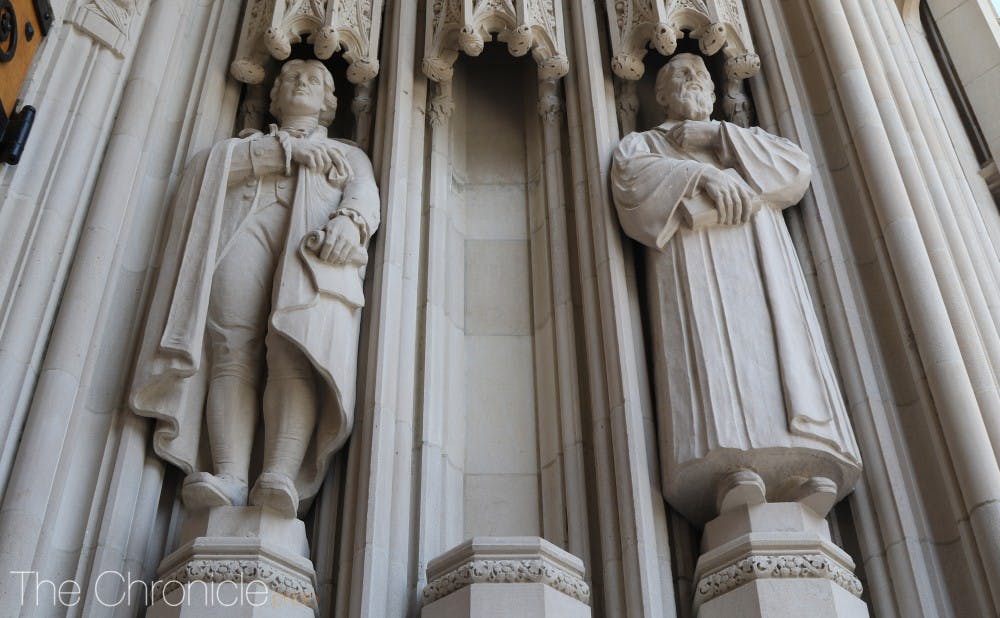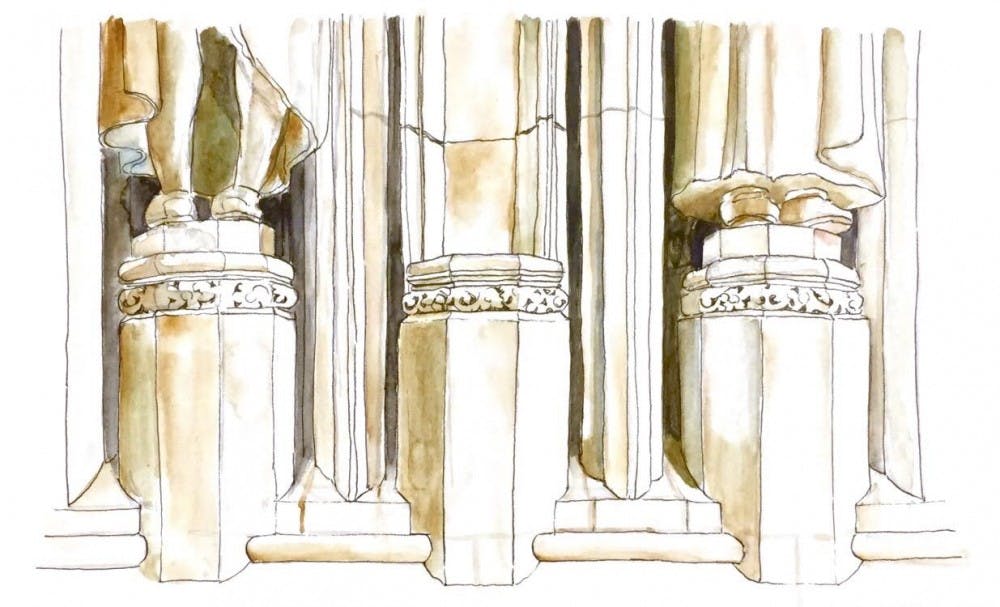Exactly one year ago, in early morning light on a near empty campus, a statue of Confederate Gen. Robert E. Lee was removed from the Chapel steps.
In the days leading up to the removal, events off of Duke’s campus had sparked a conversation about Confederate monuments. In Charlottesville, Va., white supremacists and counterprotesters clashed over a Robert E. Lee statue outside the University of Virginia’s campus.
Less than a week later, protesters toppled a Confederate statue just a few miles off of East Campus.
Around the country, Americans were grappling with the question of what should be considered proper visibility of Confederate iconography—the debates were making headlines, filling column inches and saturating the cable news cycle. Once news broke of a Confederate monument that had been at the steps of the Chapel for nearly a century, the polarizing conversation that was sparked by outside events suddenly permeated Duke’s stone walls.
“I think for a long time, especially in the South, we've had this complicit acceptance of a history of white supremacy,” said Adrienne Harreveld, Trinity ’14, who has always lived in a former Confederate state. “I think that we needed activism. We needed people throughout the country to start a dialogue on these emblems of racism.”
Alumni like Harreveld, students and faculty had strong opinions regarding the Robert E. Lee statue. Some thought that removing the statue would be akin to erasing Duke’s history. Others thought that there were ways to preserve that history without the statue, including Rob Lee IV, M.T.S. ‘17 and a descendent of Robert E. Lee.
“It's so important to contextualize our history and if we don't contextualize it, all we have are people co-opting it and making it idol to white supremacy,” he said. “So, I think it's so important for us to contextualize, to remember, but not to celebrate that dark past.”
Led by Harreveld, several hundred alumni—including Parks and Recreation actress Retta Sirleaf, Trinity '92—signed a letter vowing not to donate to the University as long as the statue stayed on campus. Earlier that day, the Robert E. Lee statue had been vandalized.
Soon after, President Vincent Price—as his first major action in office—ordered the removal of the statue with unanimous support from the Board of Trustees.
What has happened since
When the statue was removed, Price wrote in his statement that it “will be preserved so that students can study Duke’s complex past and take part in a more inclusive future.” It is currently being held in a “secured Duke storage facility,” according to Michael Schoenfeld, vice president for public affairs and government relations.
Although Price’s decision to remove the statue was met with some criticism, many students also supported him. The next month, Price created a commission to discuss what should happen to the space where the Confederate general once stood. This group—the Commission on Memory and History—would also create guidelines on how to handle the names of buildings that honor controversial figures.
A forum was hosted by Provost Sally Kornbluth on the subject of “American Universities, Monuments and the Legacies of Slavery." Duke also announced the creation of the Truth, Racial Healing and Transformation Center.
Price publicized the commission’s recommendations last December, opting to leave the empty space vacant pending an “open and deliberative process” to determine what to do about the space. Last week, he decided that the space will remain vacant for the foreseeable future with a plaque in the foyer of the Chapel explaining the empty space.
In his email to the Duke community, Price referred to Dean of the Chapel Luke Powery, who suggested the empty space could represent “a hole that is in the heart of the United States of America, and perhaps in our own human hearts—that hole that is from the sin of racism and hatred of any kind.”
Price stated that he told the Board of Trustees his decision over the summer, and received their "enthusiastic endorsement." Lee also expressed support for Price’s decision.
“I think it's important to reflect and recognize that a portion of our history was really dark and really hard for a lot of people,” he said. “I commend President Price's decision to stick to what he believes is right and I support it 100 percent.”
‘You don't hide from these pasts’
Prior to Price’s announcement, Harreveld suggested some sort of exhibit to show the history of different buildings and emblems on Duke’s campus. Price announced that Executive Vice President Tallman Trask will be tasked with finding a location for rotating exhibits about the University's history.
Robin Kirk, a lecturer in the department of cultural anthropology and faculty co-chair of the Duke Human Rights Center, noted that the University had initially stopped short of addressing the full issue by singularly removing the Lee statue.
“Many universities think, ‘Okay, we dealt with the slavery part. But that ended in 1865 and that's the end of it.’ And it's like, no, that was just the beginning,” she said.
Per a Bass Connections report supervised by Kirk, many members of Duke's postwar faculty were associated with or sympathetic toward North Carolina's white supremacy campaigns. These include former presidents Braxton Craven and John Franklin Crowell, who have West Campus quadrangles named after them, as well as philanthropist Julian Carr and faculty member William Pegram—the namesakes of two East Campus residence halls.
The Duke administration, Kirk said, should address the University's connections to white supremacy, the Jim Crow laws, the civil rights movement and its integration of new student populations.
Kirk applauded certain groups, such as Brown University and the city of Chicago, for their dedication to open dialogue and decision to build more inclusive memories. She said that moving forward, these are positive models for Duke to follow.
“You don't hide from these pasts—you delve into them, you understand them," Kirk said. "Then, you find a way to talk about them in the context of what the University wants to do better."

Students’ ‘wishlist for the University’
Price’s charge to the Commission on Memory and History to look “specifically at the Chapel space,” as Schoenfeld noted in December. Despite its narrow focus, the commission still acknowledged in their report five statues of individuals “who may not be aligned with the mission and highest values of this university.”
In Price’s email to the Duke community Thursday, he did not address the other statues—such as that of Sidney Lanier, a Confederate soldier who rose to prominence as a Southern poet after the war—or other relics to controversial post-war figures at Duke that are located elsewhere on campus.
On Thursday, Price also wrote he would task the President’s Art Advisory Committee to “identify a location and an appropriate form” to recognize individuals' whose labor built Duke’s campus, as one to commemorate the University’s first African-American students.
Kirk, who spoke to The Chronicle prior to Price’s Thursday announcement, said the onus is on the students to prioritize and be vocal about the issue.
“I think the students don't realize how much they are really listened to,” Kirk said. “If students bring this up as part of their wishlist for the University, I think that we may see some real action.”
Get The Chronicle straight to your inbox
Signup for our weekly newsletter. Cancel at any time.
Class of 2019
Editor-in-chief 2017-18,
Local and national news department head 2016-17
Born in Hyderabad, India, Likhitha Butchireddygari moved to Baltimore at a young age. She is pursuing a Program II major entitled "Digital Democracy and Data" about the future of the American democracy.

